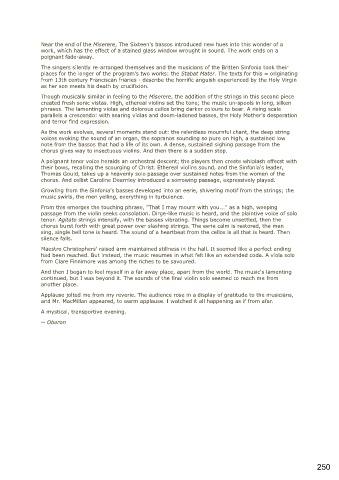Page 251 - FINAL_The Sixteen Coverage Book 40th Anniversary Year
P. 251
Near the end of the Miserere, The Sixteen's bassos introduced new hues into this wonder of a
work, which has the effect of a stained glass window wrought in sound. The work ends on a
poignant fade-away.
The singers silently re-arranged themselves and the musicians of the Britten Sinfonia took their
places for the longer of the program's two works: the Stabat Mater. The texts for this = originating
from 13th century Franciscan friaries - describe the horrific anguish experienced by the Holy Virgin
as her son meets his death by crucifixion.
Though musically similar in feeling to the Miserere, the addition of the strings in this second piece
created fresh sonic vistas. High, ethereal violins set the tone; the music un-spools in long, silken
phrases. The lamenting violas and dolorous cellos bring darker colours to bear. A rising scale
parallels a crescendo: with searing violas and doom-ladened basses, the Holy Mother's desperation
and terror find expression.
As the work evolves, several moments stand out: the relentless mournful chant, the deep string
voices evoking the sound of an organ, the sopranos sounding so pure on high, a sustained low
note from the bassos that had a life of its own. A dense, sustained sighing passage from the
chorus gives way to insectuous violins. And then there is a sudden stop.
A poignant tenor voice heralds an orchestral descent; the players then create whiplash effecst with
their bows, recalling the scourging of Christ. Ethereal violins sound, and the Sinfonia's leader,
Thomas Gould, takes up a heavenly solo passage over sustained notes from the women of the
chorus. And cellist Caroline Dearnley introduced a sorrowing passage, expressively played.
Growling from the Sinfonia's basses developed into an eerie, shivering motif from the strings; the
music swirls, the men yelling, everything in turbulence.
From this emerges the touching phrase, "That I may mourn with you..." as a high, weeping
passage from the violin seeks consolation. Dirge-like music is heard, and the plaintive voice of solo
tenor. Agitato strings intensify, with the basses vibrating. Things become unsettled, then the
chorus burst forth with great power over slashing strings. The eerie calm is restored, the men
sing, single bell tone is heard. The sound of a heartbeat from the cellos is all that is heard. Then
silence falls.
Maestro Christophers' raised arm maintained stillness in the hall. It seemed like a perfect ending
had been reached. But instead, the music resumes in what felt like an extended coda. A viola solo
from Clare Finnimore was among the riches to be savoured.
And then I began to feel myself in a far away place, apart from the world. The music's lamenting
continued, but I was beyond it. The sounds of the final violin solo seemed to reach me from
another place.
Applause jolted me from my reverie. The audience rose in a display of gratitude to the musicians,
and Mr. MacMillan appeared, to warm applause. I watched it all happening as if from afar.
A mystical, transportive evening.
~ Oberon
250

